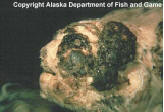| Contagious
Ecthyma (Orf) |
 |
|
| |
| Causative Agent |
-
A viral disease of sheep and goats (wild and domestic) caused by
infection with the parapoxvirus or orf
virus.
-
Disease is also referred to
as soremouth.
|
| Images |
|
Click on
image to
enlarge. |
 |
|
Typical signs of contagious
ecthyma include extensive scabbing of the face and lips. |
|
| Distribution |
|
Geographic: |
-
Present in areas of southern BC in some populations of bighorn sheep (Ovis
canadensis) and mountain goats (Oreamnos
americanus).
|
|
Seasonality: |
-
Usually reported during the rut when these species are in more close
association, and during the winter when these animals are
using road salt or salt blocks. Contagious ecthyma also is
likely to be reported during the hunting season when humans
see animals more closely.
|
|
| Hosts, Transmission and Life
Cycle |
| Hosts: |
-
Contagious ecthyma may be more likely to be transmitted to wildlife when
there is contact with domestic sheep and goats.
-
It is considered to be
endemic
in some populations of
bighorn sheep and mountain goats in BC.
-
Experimental infections in
moose (Alces alces),
white-tailed deer (Odocoileus
virginianus), and elk (Cervus
canadensis) showed that the effects were mild. Not
observed in these species in the wild.
|
|
Transmission: |
-
Likely following a similar pattern in domestic animals, transmission
occurs as a result of direct contact with infected animals
or when cuts and abrasions are in contact with contaminated
objects, such as salt blocks.
-
The
virus can survive outside of the
host for extended periods, perhaps years. Scab material lying in
places of habitual use may serve as recurring
reservoirs of infection.
|
|
Life Cycle: |
-
Presence of contagious ecthyma in bighorn sheep and mountain goats most
likely is the result of transmission of orf
virus from domestic sheep or
goats.
|
|
| Signs and Symptoms |
-
Animals may appear restless, nervous and show excessive licking of the
lips and nostrils, and scratching of the head.
-
Scabby
lesions associated with this
disease are most commonly found on the lips, skin of the face,
udder, within the mouth and above the hooves.
-
Lesions
range in size from tiny
crusts to large merging scabs that may cover the lips.
-
If mouth
lesions are severe enough, animals
will not feed; lameness may ensue due to
lesions on the feet in young
animals. Both scenarios may lead to loss of condition or death by
starvation.
-
Generally, affected animals
recover uneventfully; however, in severe outbreaks, death may occur
in younger animals.
-
Initial scabs form 7 days
after infection followed by a 10 day cycle of
pustules to scabs.
-
After 3 weeks,
lesions begin to subside and
typically do not scar.
-
Short-term
immunity (up to 5 months) is thought
to occur following an infection.
|
| Meat Edible? |
-
Meat from an infected animal is suitable for consumption; however, trim
off affected parts.
-
Meat from severely affected animals may be of inferior quality due to the
poor condition of the animal.
|
| Human Health Concerns and
Risk Reduction |
-
Orf, or contagious ecthyma, is a
zoonosis and, as such, appropriate
precautions should be taken when handling an animal suspected of
having this disease.
-
Orf is an occupational
hazard of those who handle domestic goats and sheep.
-
In humans,
lesions similar to those in
animals, including swollen/painful
lymph nodes and mild fever, may occur.
Skin
lesions usually subside within 6
weeks without scarring. Most likely to be contracted by humans
during the hunting season when hunters are in direct contact with
infected animals.
|
| Samples for Diagnosis |
-
Scabs and the tissue immediately surrounding the scabs.
|
| Further Reading |
-
Alaska Department of Fish and Game – Contagious Ecthyma
-
BC Ministry of Environment Wildlife Health Fact Sheet – Contagious Ecthyma (PDF
file)
-
Elkin B., Zamke R.L. 2001.
Common Wildlife Diseases and
Parasites in Alaska. Alaska Department of Fish and Game.
Anchorage, AK.
-
Robinson A.J., Kerr P.J.
2001. Poxvirus infections. Pp. 179-201 in E.S. Williams, I.K. Barker
(eds.), Infectious Diseases of
Wild Mammals. 3rd Ed. Iowa State University Press. Ames, IA.
|
|
|

